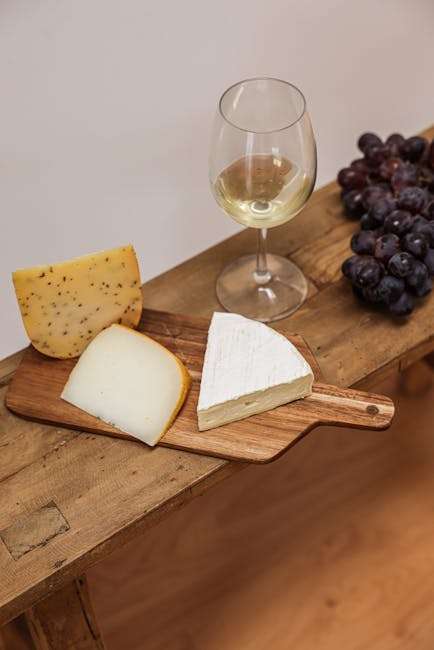A Beginner’s Guide to Pairing Wine with Food ???
Wine and food pairing can often seem like a sophisticated art reserved for sommeliers and gourmet chefs. However, with a bit of knowledge and experimentation, anyone can elevate their dining experience. This guide aims to demystify the process, offering straightforward advice for beginners looking to enhance their meals with the perfect wine. Let’s dive into the delightful world of wine and food pairing!
Table of Contents
1. Understanding the Basics of Wine Pairing
2. Pairing by Wine Type
3. Classic Pairings to Try
4. Tips and Tricks for Successful Pairing
5. Conclusion
6. FAQ Section
Understanding the Basics of Wine Pairing ?
The key to pairing wine with food lies in balancing flavors and enhancing the dining experience. Here are some foundational principles:
1. Complementary Flavors
Think of wine as a seasoning. It should complement the dish, not overpower it. For example, a creamy pasta dish pairs wonderfully with a rich Chardonnay, whose buttery notes enhance the creaminess.
2. Contrasting Flavors
Sometimes, opposites attract. A sweet wine like Riesling can contrast beautifully with spicy dishes, cutting through the heat and providing a refreshing balance.
3. Similar Weight and Body
Light-bodied wines pair best with lighter dishes, while full-bodied wines complement heartier fare. A delicate Pinot Noir with grilled salmon is a classic example of matching body and weight.
Pairing by Wine Type ?
White Wines
White wines are generally more acidic, making them a great match for lighter dishes. Here are a few pairings to consider:
Sauvignon Blanc: Pairs well with tangy goat cheese, salads with vinaigrette, and seafood.
Chardonnay: Complements creamy sauces, chicken, and grilled vegetables.
Red Wines
Red wines are often richer and more tannic, ideal for robust dishes. Try these pairings:
Cabernet Sauvignon: Perfect with grilled steaks, lamb, and aged cheeses.
Pinot Noir: Versatile enough for poultry, salmon, and mushroom dishes.
Rosé and Sparkling Wines
These wines are incredibly food-friendly and can adapt to a variety of dishes:
Rosé: Pairs well with charcuterie, salads, and light pastas.
Sparkling Wine: Excellent with fried foods, shellfish, and fruit-based desserts.
Classic Pairings to Try ??
Here are some time-tested pairings that never fail to impress:
1. Chianti and Pizza
The acidity and fruitiness of Chianti make it a natural partner for the rich, tomato-based flavors of pizza.
2. Sauternes and Blue Cheese
This sweet wine contrasts with the saltiness and boldness of blue cheese, creating a harmonious balance.
3. Champagne and Oysters
The effervescence of Champagne cleanses the palate, making it an exquisite match for the briny, delicate flavor of oysters.
Tips and Tricks for Successful Pairing ?
Here are some handy tips to refine your pairing skills:
Experiment and Have Fun
Don’t be afraid to try unconventional pairings. Wine tasting is subjective, and personal preference plays a significant role. Trust your palate and have fun experimenting!
Consider the Sauce
Often, the sauce is the dominant flavor in a dish. For instance, a tomato-based sauce might pair better with a red wine, while a cream sauce could be complemented by a white wine.
When in Doubt, Opt for Versatility
If you’re unsure, choose wines known for their versatility, like Pinot Noir or a dry rosé. These wines tend to complement a wide range of dishes.
Conclusion: Cheers to New Adventures! ?
Pairing wine with food doesn’t have to be intimidating. With these tips and a bit of practice, you’ll soon be able to impress your friends and family with exquisite pairings. Remember, the goal is to enhance your dining experience, so relax, sip, and savor the journey!
FAQ Section ????
Q1: What is a good beginner wine for pairing with food?
A versatile wine like Pinot Noir or a dry rosé is great for beginners, as they pair well with a variety of dishes.
Q2: How do I know if a wine is too tannic for a dish?
If the wine overpowers the flavors of the dish and leaves a bitter taste, it might be too tannic. Pair tannic wines with rich, fatty foods to balance the flavors.
Q3: Can I pair wine with dessert?
Absolutely! Sweet wines like Moscato or Port pair beautifully with desserts. Just ensure the wine is sweeter than the dessert to avoid a bitter taste.
Q4: Is it okay to chill red wine?
Yes, some lighter reds like Pinot Noir can be slightly chilled to enhance their fruity flavors, especially in warmer weather.
Q5: What if I don’t like the wine pairing I chose?
No worries! Wine pairing is all about personal preference. Take notes on what you like and don’t like, and use that to guide future selections.
